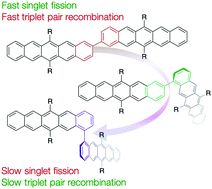Abstract
We investigate triplet pair dynamics in pentacene dimers that have varying degrees of coplanarity (pentacene–pentacene twist angle). The fine-tuning of the twist angle was achieved by alternating connectivity at the 1-position or 2-positions of pentacene. This mix-and-match connectivity leads to tunable twist angles between the two covalently linked pentacenes. These twisted dimers allow us to investigate the subtle effects that the dihedral angle between the covalently linked pentacenes imparts on singlet fission and triplet pair recombination dynamics. We observe that as the dihedral angle between the two bonded pentacenes is increased, the rates of singlet fission decrease, while the accompanying decrease in triplet recombination rates is stark. Temperature-dependent transient optical studies combined with theoretical calculations show that the triplet pair recombination proceeds primarily through a direct multiexciton internal conversion process. Calculations further show that the significant decrease in recombination rates can be directly attributed to a corresponding decrease in the magnitude of the nonadiabatic coupling between the singlet multiexcitonic state and the ground state. These results highlight the importance of the twist angle in designing systems that exhibit rapid singlet fission, while maintaining long triplet pair lifetimes in pentacene dimers.

- This article is part of the themed collection: Special issue in honour of Seth Marder


 Please wait while we load your content...
Please wait while we load your content...